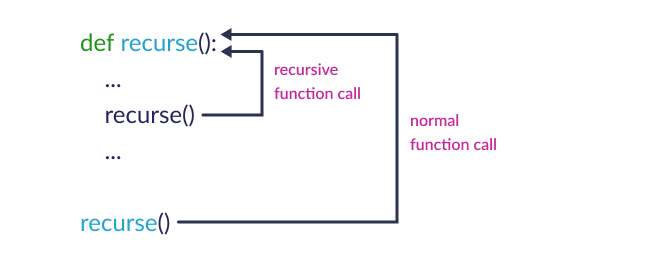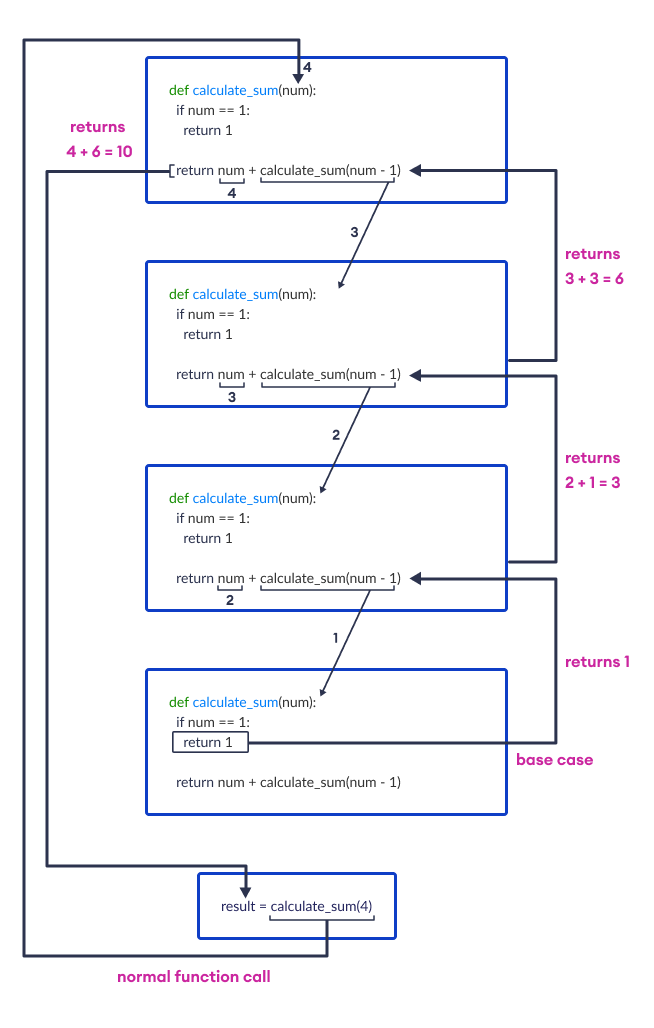Python Recursion Example | Recursion In Python Programming
Python Recursion is the method of programming or coding the problem, in which the function calls itself one or more times in its body. Usually, it is returning a return value of this function call. If the function definition satisfies the condition of recursion, we call this function a recursive function.
Working of Recursion in Python
def recurse():
...
recurse()
...
recurse()The recurse() function calls itself over and over again. The figure below shows how recursion works.

Example: Recursion
def greet():
print('Hello')
# recursive call
greet()
# normal function call
greet()Output
Hello Hello Hello Hello .. ..
The above program will call itself infinitely. Hence, we must include a stopping condition to stop the recursive call.
Stopping Condition for Recursion
If we do not include a stopping condition to stop the recursive call, the function will keep calling itself infinitely.
We generally use the if...else statement to stop the recursion.
def recurse():
if condition:
# condition to break recursion
else:
# recursive call
recurse()In the above code, the if statement stops the recursive call and the else statement calls the function recursively.
Example: Recursion With Stop Condition
def print_number(number):
# print number
print(number)
# stopping condition
if number == 0:
print('Stop Printing')
else:
# recursive call
print_number(number - 1)
print_number(2) Output
2
1
0
Stop PrintingIn the above example, we have created a recursive function named print_number(). Here, the function calls itself until the number passed to it becomes 0.
Working of the code:
| Function call | Prints | number == 0 ? |
|---|---|---|
print_number(2) | 2 | False |
print_number(2 - 1) | 1 | False |
print_number(1 - 1) | 0Stop Printing | True [function call stops] |
Example: Sum of Natural Numbers
def calculate_sum(num):
# stopping condition
if num == 1:
return 1
# recursive call
return num + calculate_sum(num - 1)
result = calculate_sum(4)
print(result) Output
10The calculate_sum(num) function calculates the sum of all integers from num to 1 using recursion.
If num equals 1, it simply returns 1 since that's the base case. Otherwise, it returns num plus the result of a recursive call to calculate_sum(num - 1).
Here, calculate_sum(4) computes the sum of 4, 3, 2, and 1, which is 10.
Working of the Sum of Natural Numbers

Advantages and Disadvantages of Recursion
The advantages and disadvantages of using recursion in Python are as follows:
Advantages
- Recursion makes our code shorter and cleaner.
- It is required in data structures and algorithms, such as Graph and Tree Traversal.
Disadvantages
- Recursion uses more processor time.
- Recursive functions are more difficult to debug compared to an equivalent iterative program.
Learn More:
In this tutorial, we will talk about recursion and how we can use it to divide and conquer! We will also see which is faster - recursive functions or for loops?? we will compare between the two by recreating the Fibonacci Sequence and running a speed test!
⏰ TIME STAMPS ⏰
***************************
00:00 - Intro
00:15 - What is Recursion
01:03 - Python Recursive Function Code Example
02:43 - Fibonacci Sequence
03:49 - Fibonacci Recursion Code Example
05:21 - Fibonacci Iteration Code Example
06:56 - Is Python Recursion Faster than Iteration?
08:25 - Divide and Conquer
08:48 - Thanks for Watching!
#python #python recursion
